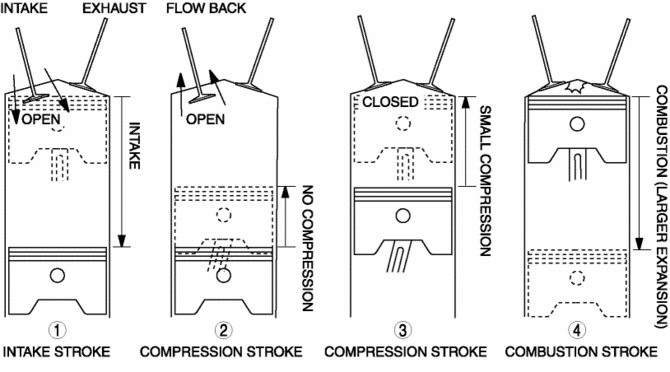Mazda CX-5 Service & Repair Manual: Miller Cycle Engine
Outline
-
The Miller cycle engine is a high-efficiency engine which achieves high fuel economy performance by obtaining a high-expansion ratio.
-
The Miller cycle engine achieves a high-expansion ratio without increasing its effective compression ratio by retarding the intake air valve close timing.
Operation
1. Intake air is introduced into the cylinder.
2. The intake valve is kept open after the intake stroke is finished to force the air in the cylinder to flow back to the intake pipe.
3. The compression stroke starts from the position in which the intake valve is closed (small compression).
4. The air-fuel mixture is combusted and the piston is pushed down to BDC (large expansion).

 Mechanical
Mechanical
Outline
The sliding resistance*1 has been reduced by:
the adoption of a rocker arm (built into needle roller bearing)
reducing load on the valve spring
narrow ...
 Non Return Valve Inspection
Non Return Valve Inspection
WARNING:
Fuel is very flammable liquid. If fuel spills or leaks from the pressurized
fuel system, it will cause serious injury or death and facility breakage. Fuel
can also irritate skin ...
Other materials:
Interior Care
WARNING
Do not spray water in the cabin:
Splashing water on electrical parts such as the audio unit and switches is dangerous
as it could cause a malfunction or a fire.
Dashboard Precautions
Prevent caustic solutions such as perfume and cosmetic oils from contacting the
dashboard. They will ...
Wheel Apron Component Removal [Panel Replacement]
Symbol Mark
Removal Procedure
1. Drill the 14 locations indicated by (A) from the front wheel housing side
shown in the figure.
2. Drill the 11 locations indicated by (B) shown in the figure.
3. Drill the 4 locations indicated by (C) shown in the figure.
NOTE:
When drilling t ...
Sunvisors
When you need a sunvisor, lower it for use in front or swing it to the side.
Side Extension Sunvisors
The visor extender extends the sunvisor's range of sun shading.
To use, pull it out.
CAUTION
When moving the sunvisor, retract the visor extender to its original position.
Otherwise, ...
